
Copyright © 2025 The Author(s): This is an open-access article distributed under the terms of the Creative
Commons Attribution 4.0 International License (CC BY-NC 4.0)
International Journal of Scientific Research in Science and Technology
Available online at : www.ijsrst.com
Print ISSN: 2395-6011 | Online ISSN: 2395-602X
doi : https://doi.org/10.32628/IJSRST25121216
120
The Synergistic Impact of AI, IoT, Blockchain, 5G, and Cloud Computing on
Supply Chain Resilience in Vietnam
Lai Nam Tuan
Faculty of Management, Ho Chi Minh City University of Law
lntuan@hcmulaw.edu.vn
A R T I C L E I N F O
A B S T R A C T
Article History:
Accepted : 01 March 2025
Published: 04 March 2025
The integration of Artificial Intelligence (AI), the Internet of Things (IoT),
Blockchain, 5G, and Cloud Computing is revolutionizing supply chain
management, enhancing efficiency, transparency, and resilience. This
study explores Vietnam’s strategic approach to adopting these
technologies, emphasizing the necessity of advanced infrastructure,
workforce development, and adaptive regulatory frameworks. Key policy
recommendations include investing in resilient data centers, expanding 5G
networks, and fostering public-private partnerships to create a robust
digital ecosystem. Additionally, the study highlights the importance of
education and vocational training in AI, cybersecurity, and digital supply
chain management to bridge the skills gap. Regulatory improvements in
data protection, electronic transactions, and intellectual property rights are
essential for mitigating risks and encouraging technological innovation.
Keywords: Artificial Intelligence, Internet of Things, Blockchain, 5G,
Cloud Computing, Technological Innovation, Vietnam.
Publication Issue :
Volume 12, Issue 2
March-April-2025
Page Number :
120-128
I. INTRODUCTION
In the context of globalization and rapid technological
advancements, supply chain management has become
a critical determinant of business success. The
integration of advanced technologies such as Artificial
Intelligence (AI), the Internet of Things (IoT),
Blockchain, 5G, and Cloud Computing is
revolutionizing supply chain operations, enhancing
efficiency, transparency, and adaptability in an
increasingly complex business environment [1]. These
digital innovations, particularly within the framework
of Industry 4.0, are reshaping traditional supply chain
models by improving predictive capabilities,
optimizing workflows, and fostering greater resilience
to market fluctuations [1]. AI and IoT play a pivotal
role in real-time data collection and analytics,
enabling precise demand forecasting, inventory
optimization, and proactive decision-making By
leveraging AI-driven predictive analytics, companies
can mitigate risks associated with supply chain
disruptions. This approach also enhances operational

International Journal of Scientific Research in Science and Technology (www.ijsrst.com) | Volume 12 | Issue 2
Lai Nam Tuan Int J Sci Res Sci & Technol. March-April-2025, 12 (2) : 120-128
121
efficiency and allows firms to monitor logistics, track
shipments, and manage warehouse operations more
effectively [2].
Blockchain technology improves supply chain security
by ensuring transparency and traceability of
transactions. It creates decentralized and
unchangeable ledgers, which reduces fraud risks,
increases accountability, and simplifies contract
management with smart contracts [3]. These features
are especially useful for industries with strict
regulations, like pharmaceuticals and food supply
chains. At the same time, 5G technology enhances
connectivity and real-time communication in supply
chain networks. Its fast data transmission and low
latency support automation, remote monitoring, and
predictive maintenance, which helps reduce
downtime and make supply chains more agile [4].
Cloud computing complements these technologies by
providing scalable storage, real-time data access, and
integrated systems for managing resources, creating a
smooth digital supply chain ecosystem. The use of
advanced technologies like Artificial Intelligence (AI),
the Internet of Things (IoT), Blockchain, 5G, and
Cloud Computing is rapidly changing global supply
chains and transforming traditional operations.
Vietnam is growing economically and aims to
integrate into the global market. Implementing these
technologies is essential for success.
This study looks at how these technologies affect the
competitiveness of Vietnam's supply chain sector,
which is vital for the country's economy. While
previous research has recognized the potential of
these technologies, there is still a lack of
understanding about their specific applications and
impacts in Vietnam. This research addresses that gap
by analyzing how using these technologies together
can improve supply chain performance for some
Vietnamese companies. By exploring real-world
examples and challenges faced by local businesses, this
study provides insights on how these technologies can
enhance resilience, cut costs, and deliver better value
to consumers. Additionally, it contributes to the wider
conversation about digital transformation in emerging
economies by offering practical recommendations
tailored to Vietnam's unique supply chain context.
The remaining section of this paper is structured as
follows. Section 2 establishes the theoretical
framework investigating the adoption of Artificial
Intelligence (AI), the Internet of Things (IoT),
Blockchain, 5G, and Cloud Computing within the
context of supply chain management. Furthermore,
Section 2 presents a comparative analysis of real-
world applications of these technologies, examining
both successful implementations by established global
enterprises and emerging case studies from
Vietnamese firms. This comparative approach
facilitates the identification of best practices and
contextual challenges specific to the Vietnamese
market. Section 3 critically reviews the contemporary
Vietnamese governmental policies designed to
facilitate the integration and utilization of these
technologies within the supply chain sector. Finally,
Section 4 synthesizes the key findings of the research,
drawing upon the theoretical and empirical evidence
presented in earlier sections. It also suggests some
policy recommendations to foster a favourable
environment for technology adoption and enhancing
the competitiveness of Vietnam's supply chain sector
in the global arena.
II. LITERATURE REVIEW
2.1. Artificial Intelligence (AI) in Supply Chain
Management: The "Intelligent Brain":
Artificial Intelligence (AI) includes advanced
technologies that help machines mimic human
intelligence. This enables automation, predictive
analytics, and performance improvement. AI-driven
supply chain solutions use machine learning (ML) and
deep learning (DL) to analyze large amounts of data.
This improves decision-making, demand forecasting,
inventory management, and logistics [2], [5]. AI
strengthens supply chain resilience by spotting
patterns in consumer behavior and market trends.

International Journal of Scientific Research in Science and Technology (www.ijsrst.com) | Volume 12 | Issue 2
Lai Nam Tuan Int J Sci Res Sci & Technol. March-April-2025, 12 (2) : 120-128
122
This helps businesses adjust their strategies to reduce
disruptions. Major companies have successfully added
AI to their supply chain operations, boosting
efficiency and cutting costs. For example, Amazon
uses AI-powered robots and predictive analytics to
optimize its warehouse operations, improving
efficiency, productivity, and labor control. Amazon
Robotics, formerly Kiva Systems, uses autonomous
mobile robots to move goods in fulfillment centers.
This reduces human travel time by 60% and boosts
picking efficiency by 20-40%, allowing millions of
packages to be delivered daily. AI-driven forecasting
models also study customer behavior, inventory
turnover, and regional demand to place products
closer to consumers. Similarly, Alibaba's logistics arm,
Cainiao, uses AI in smart warehouses. It employs
automated guided vehicles and real-time data analysis
to improve delivery efficiency. Alibaba’s AI smart
routing system has increased last-mile delivery
efficiency by 10-15% and reduced operational costs by
20% [6].
While AI adoption in Vietnam's supply chain
management remains initial. The current applications
are primarily centered on demand forecasting and
data analytics. Only prominent industry leaders like
Vingroup and FPT Corporation are actively
pioneering AI-driven logistics initiatives to enhance
operational efficiency. Bui, Nguyen, Nguyen, Pham, &
Phung (2023) discuss the development of artificial
intelligence (AI) in Vietnam and suggest a
collaboration between academia, industry, and
government [7]. Vingroup recognized the strategic
importance of artificial intelligence in driving
innovation and enhancing operational efficiency, and
established VinAI Research in 2019. These authors
also emphasize VinAI's commitment to building a
skilled workforce and fostering partnerships with
universities and international organizations. Likewise,
FPT Corporation, a top technology company in
Vietnam, has established itself as a major force in
driving digital transformation in the logistics sector.
As evidenced by Truong & Truong (2024), FPT
Corporation is actively investing in the development
and deployment of AI-powered logistics platforms [8].
This uses machine learning to optimize delivery
routes and explores robotic process automation in
warehouse management, which reduces costs and
improves accuracy. These trials by major companies
show a growing awareness of AI's potential to change
Vietnam's supply chain. The rising use of AI in this
sector offers great opportunities for improving
efficiency, reducing costs, and gaining a competitive
edge.
2.2. Internet of Things (IoT) in Supply Chain
Management: The "Connected Network":
The Internet of Things (IoT) refers to a network of
connected devices that collect and exchange real-time
data, transforming supply chain management (SCM)
through automation, visibility, and predictive
analytics. IoT-powered solutions enable real-time
tracking, warehouse optimization, and enhanced
production efficiency, creating a data-driven
ecosystem for logistics and manufacturing [9]. Global
logistics giants UPS and DHL exemplify the
transformative potential of IoT integration within
supply chain networks, achieving substantial cost
reductions and operational efficiencies. UPS, through
its "ORION" system deploying IoT-driven smart
sensors and telematics, optimizes over 200,000 routes
daily [10]. Thus it helps to yield an annual fuel saving
of approximately 10 million gallons and a delivery
time reduction of 8-10%. The smart package initiative,
which utilizes RFID tags, reduces package loss by 20%
and enhances delivery accuracy. Similarly, DHL's
implementation of IoT-based smart warehousing and
real-time tracking systems has resulted in a 99.5%
inventory accuracy and a 30% decrease in warehouse
operating costs [11]. Its fleet management system
reduces transit delays by 15%, thereby enhancing
supply chain agility. Further, DHL's smart
temperature-controlled packaging shows how IoT is
used in cold chain logistics. This technology reduces
spoilage of perishable goods by 20-25%, benefiting
pharmaceutical and food supply chains significantly.

International Journal of Scientific Research in Science and Technology (www.ijsrst.com) | Volume 12 | Issue 2
Lai Nam Tuan Int J Sci Res Sci & Technol. March-April-2025, 12 (2) : 120-128
123
On the other hand, Vietnamese companies like
VinEco and ViettelPost are increasingly using IoT
solutions to improve their supply chain operations. As
a part of the Vingroup conglomerate, VinEco is a
Vietnamese agricultural company that specializes in
producing high-quality, safe, and sustainable
agricultural products [12]. The author provides a
contextual framework for understanding the broader
adoption of IoT in the Vietnamese agricultural sector.
This technology helps the firm to achieve a 30%
increase in water efficiency and a 20-25% boost in
crop yields through real-time environmental
monitoring and automated systems. In the same way,
Watts (2024) explains how ViettelPost, one of
Vietnam’s largest logistics providers, has strategically
deployed IoT technologies to improve real-time
tracking, optimize fleet management, and streamline
warehousing processes [13]. This application results in
a 15% reduction in vehicle downtime, 98% delivery
accuracy, and a 40% decrease in lost shipments.
Therefore, the strategic integration of IoT within
Vietnam's logistics and supply chain sector presents
substantial growth prospects.
2.3. Blockchain in Supply Chain Management: The
"Trusted Ledger":
Blockchain is a decentralized digital ledger that allows
secure, transparent, and tamper-proof recording of
transactions [3]. It removes the need for
intermediaries and improves efficiency using
cryptographic algorithms. Companies like IBM and
Maersk are leading the way in using Blockchain for
supply chain and logistics. IBM’s Food Trust
Blockchain cuts the time to track foodborne illnesses
from seven days to just 2.2 seconds, enabling quick
product tracing [14]. The IBM-Maersk platform,
TradeLens, handles over 12 million shipping events
daily [15]. It helps to reduce documentation errors by
40% and shipment delays by 20%. TradeLens also uses
smart contracts to automate customs clearance, which
could save the shipping industry $38 billion each year.
As a result, the use of Blockchain in logistics is
expected to grow significantly, driven by the need for
better traceability and fraud prevention.
Vietnamese enterprises are actively experimenting
with Blockchain technology to support transparency
within agriculture and logistics. For instance, Moca is
a digital payment platform owned by Grab, a leading
ride-hailing and food delivery service in Southeast
Asia. It applies Blockchain for secure, traceable, and
automated payment solutions in supply chain
financing, leading to a 35% reduction in invoice fraud
and a 50% improvement in transaction speed through
Blockchain-based smart invoices [16]. Besides, TE-
Food is Vietnam's largest Blockchain-based
agricultural traceability system [17]. It tracks over
6,000 farms and 10,000 supply chain partners to
ensure end-to-end transparency for perishable goods
via its QR-code Blockchain system. Consequently it
helps to reduce food fraud incidents by 31%.
Moreover, the Vietnamese government is exploring
Blockchain applications in customs clearance and
trade finance, with aspirations to reduce
import/export paperwork by 60% and streamline trade
processing times by 30% [18]. Therefore, Blockchain
presents transformative opportunities for Vietnamese
enterprises aiming to enhance logistics, mitigate fraud,
and improve transparency. Despite challenges like
unclear regulations, high costs, and scalability issues,
careful planning is needed. However, by following
global best practices, Vietnam could improve supply
chain efficiency and cut compliance costs through
Blockchain integration. This gives Vietnam the
potential to become a regional leader in digital supply
chain innovation.
2.4. 5G in Supply Chain Management: The "High-
Speed Transmission":
The fifth-generation (5G) mobile network is well-
known for its fast data transfer and low lag. It is
speeding up digital changes in supply chain
management (SCM) and improving efficiency. Global
leaders like the U.S., China, and South Korea have
strategically employed 5G to optimize transport,
inventory, and automation. In the U.S., collaborations

International Journal of Scientific Research in Science and Technology (www.ijsrst.com) | Volume 12 | Issue 2
Lai Nam Tuan Int J Sci Res Sci & Technol. March-April-2025, 12 (2) : 120-128
124
between Verizon and Amazon have implemented 5G-
powered autonomous robots in warehouses [19]. This
leads to a 25% increase in order fulfillment and a 30%
reduction in labor costs. Nam (2022) also discussed
how advancements in 5G technology and edge
computing may impact automakers like Ford Motor
Company [19]. The company leverages 5G for smart
manufacturing, reducing production downtime
through real-time predictive maintenance. China has
pioneered 5G-integrated ports, enhancing efficiency,
automation, and logistics transparency [4]. The
technologies like Low Earth Orbit satellite
communications improve real-time vessel tracking,
automated cranes, and AI-driven container
management. Consequently it leads to a 20%
reduction in container handling times, optimizing
ship turnaround and a 15% decrease in overall
logistics costs through real-time monitoring of
shipments. As evidenced by SK Telecom's integration
of these technologies with the Metaversehe, the
convergence of 5G and AI is further revolutionizing
logistics [20]. This AI-supported framework enables
virtual simulations, real-time collaboration, and
predictive modeling, resulting in a 30% reduction in
delivery times and a 25% reduction in operational
costs. These advancements underscore the
transformative potential of 5G-integrated, AI-driven
logistics ecosystems in enhancing efficiency and
resilience.
Vietnam is testing 5G technology for smart city
projects and logistics, led by Viettel and VNPT.
Viettel's 5G Smart City Initiative has introduced 5G
surveillance and AI traffic monitoring in Hanoi and
Ho Chi Minh City [21]. It aims to reduce congestion
by 35% and improve logistics planning. Additionally,
5G-connected drones have increased supply chain
visibility by 45% and sped up deliveries. Long,
Agrawal, Trung, and Pham (2021) also demonstrate
that VNPT is deploying 5G in logistics and Industry
4.0 [22]. They are testing 5G logistics hubs equipped
with IoT sensors and AI. This initiative aims to
enhance warehouse automation and reduce inventory
errors by 30%. They are running smart manufacturing
trials in Ho Chi Minh City, achieving a 20% increase
in production efficiency and a 25% reduction in
energy use. Overall, 5G technology could transform
Vietnam’s supply chain by improving tracking,
automation, and efficiency. However, challenges like
high infrastructure costs, cybersecurity risks, and
regulatory issues remain. Studies indicate that 5G
could boost operational efficiency by 30-50% and
lower supply chain costs by 15-25%, giving Vietnam a
chance to compete in the global digital logistics
market and drive industrial innovation as it expands
its 5G infrastructure.
2.5. Cloud Computing in Supply Chain Management:
A Flexible Data Hub:
Cloud computing is changing global supply chain
management. It offers on-demand resources for data
storage, processing, and real-time analytics. This
eliminates the need for local hardware [23].
Wankhede, Talati, and Chinchamalatpure (2020)
compare major cloud platforms like Microsoft Azure,
Google Cloud Platform, and Amazon EC2,
highlighting their unique features for advanced
technology use [24]. For example, Microsoft Azure is
known for its strong support of blockchain-based
supply chain tracking. Coca-Cola uses this technology
to enhance transparency and traceability in its supply
chain. By using Azure's blockchain capabilities,
companies can securely record every transaction and
movement of goods in real time. This helps reduce
risks like counterfeiting and fraud while ensuring
compliance with regulations. This integration
streamlines logistics, improves efficiency, and builds
consumer trust by providing proof of product origin.
Further, Lee (2021) emphasizes the critical role of
digital-based supply chain integration in enhancing
firm performance across different national contexts,
including Vietnam [25]. In Vietnam’s supply chains,
cloud adoption has emerged as a key technological
enabler. Cloud computing platforms facilitate real-
time data sharing and seamless communication among
suppliers, manufacturers, and distributors, thereby




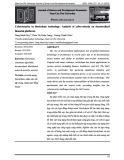
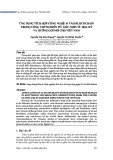

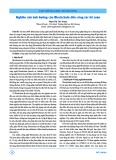

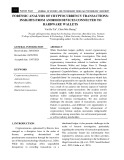
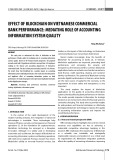







![Fintech và Ngân hàng tại Việt Nam: Hợp tác hay Cạnh tranh? [Phân tích mới nhất]](https://cdn.tailieu.vn/images/document/thumbnail/2025/20250628/nomoney1/135x160/3441751105045.jpg)







